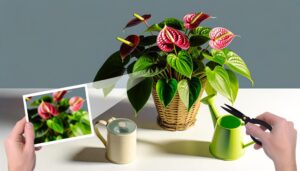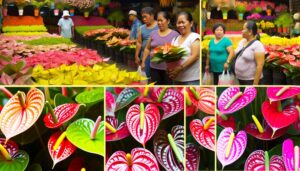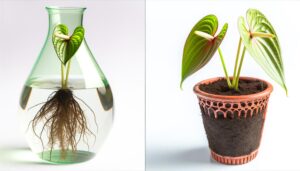How to Use Succulent Soil for Anthurium: A Complete Guide!
To use juicy soil for your anthurium, blend perlite, peat moss, and orchid bark to maximize aeration and moisture retention. You might add activated charcoal to absorb impurities and coconut coir or sphagnum moss for balanced moisture.
Choose a pot with drainage holes and use terra cotta for improved air circulation. Water thoroughly but guarantee proper drainage to avoid root rot.
Position your anthurium in bright, indirect light and adjust care based on seasonal changes. If you want to delve deeper, there are plenty of nuances to explore for best anthurium care.

Key Takeaways
- Ensure the soil mix includes perlite, peat moss, and orchid bark for optimal aeration and drainage.
- Add activated charcoal to the soil mix to absorb impurities and maintain cleanliness.
- Choose pots with drainage holes to prevent water accumulation and root rot.
- Water thoroughly and allow excess water to drain out to avoid overwatering.
- Place the Anthurium in bright, indirect light to support healthy growth.
Benefits of Succulent Soil
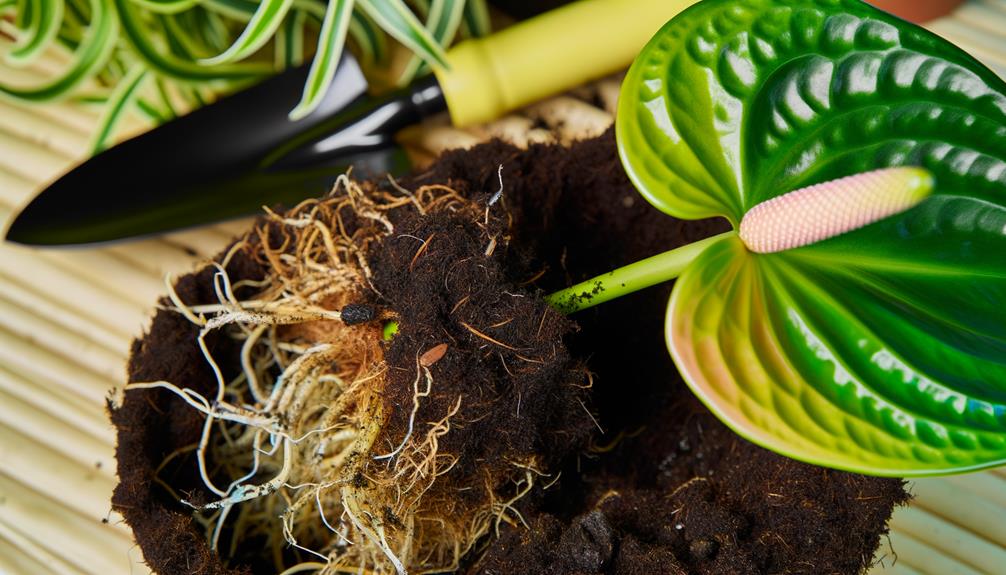
One of the primary benefits of using succulent soil for anthurium is its exceptional drainage capability, which prevents root rot and promotes healthy growth.
This soil type typically contains components like perlite, pumice, and coarse sand, ensuring that water doesn’t stagnate around the roots. By facilitating rapid water movement, you’re minimizing the risk of fungal infections.
Additionally, succulent soil offers aeration, allowing oxygen to reach the root system more efficiently. This is essential for anthurium, as their roots thrive in well-oxygenated environments.
When you use succulent soil, you’re ensuring that your anthurium receives the right balance of moisture and air, leading to robust, vibrant plants. By managing these crucial factors, you’re fostering an ideal growing environment.
Choosing the Right Mix
To select the best mix for your Anthurium, focus on essential soil components like perlite, orchid bark, and peat moss. These elements guarantee proper aeration and moisture retention, mimicking the plant’s natural habitat.
Aim for a well-draining, loose texture to prevent root rot and promote healthy growth.
Essential Soil Components
Selecting the right mix for anthurium involves understanding the essential soil components that provide ideal aeration, drainage, and nutrient retention.
- First, incorporate orchid bark, which enhances aeration and prevents waterlogging.
- Next, use perlite to improve drainage, ensuring that excess water doesn’t suffocate roots.
- Coconut coir is an excellent addition for moisture retention while still allowing air pockets.
- Finally, add activated charcoal to filter impurities and maintain soil freshness.
Each component serves a distinct purpose: orchid bark for structure, perlite for drainage, coconut coir for moisture balance, and activated charcoal for cleanliness.
Ideal Soil Texture
Achieving the perfect soil texture for anthurium requires a careful balance of coarse and fine materials to guarantee root health and plant growth. You’ll need to create a mix that provides excellent drainage, aeration, and nutrient retention.
Start with a base of succulent soil and enrich it with organic matter like orchid bark or coconut coir.
These materials ensure the roots have enough oxygen and prevent waterlogging, which can lead to root rot.
Here’s a quick reference for your ideal mix:
| Component | Percentage |
|---|---|
| Succulent Soil | 50% |
| Orchid Bark | 30% |
| Coconut Coir | 20% |
This blend offers the perfect texture, allowing your anthurium to thrive. Regularly check the soil condition and adjust as needed to maintain the best possible texture.
Preparing the Soil
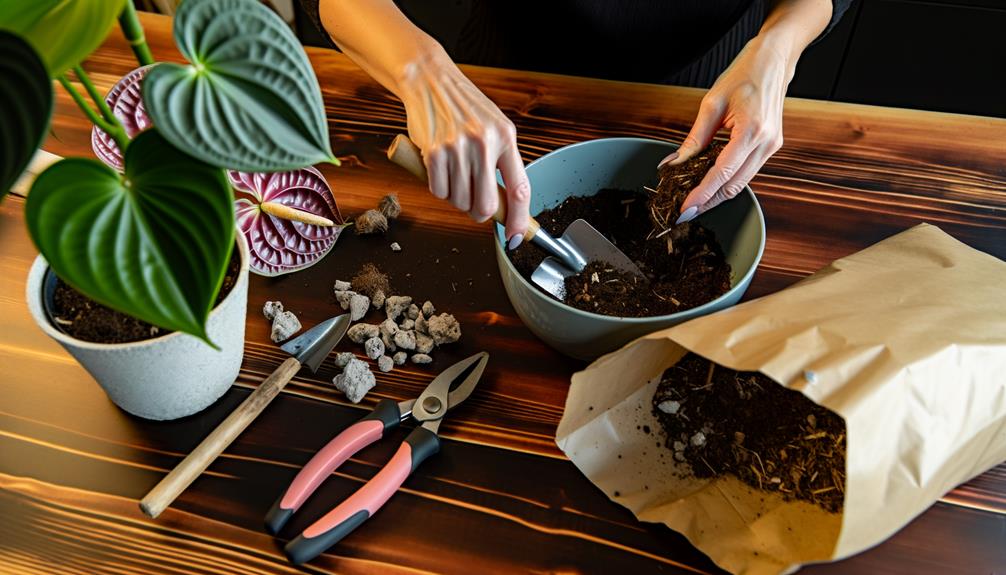
Start by guaranteeing the soil mix you use for your Anthurium is well-draining and rich in organic matter. Best drainage prevents root rot and mimics the plant’s natural habitat.
Use a soil with a pH between 5.5 and 6.5 to promote nutrient availability. Sterilize the soil to eliminate pests and pathogens that could harm your Anthurium. You can do this by baking it at 180°F for 30 minutes.
Ensure the soil has a coarse texture by incorporating coarse sand or perlite. This enhances aeration and drainage, essential for Anthuriums. Avoid compacting the soil, as it reduces oxygen flow to the roots.
Preparing the soil meticulously guarantees your Anthurium thrives, providing vibrant blooms and lush foliage.
Mixing Ingredients
When mixing ingredients for anthurium soil, prioritize choosing soil components that enhance aeration and moisture retention.
Incorporate elements like perlite, orchid bark, and peat moss to achieve proper drainage and mimic the plant’s natural habitat.
Carefully balance these ingredients to create an ideal growing medium that prevents root rot while supporting healthy growth.
Choosing Soil Components
Frequently, the key to crafting the perfect soil mix for your anthurium lies in selecting the right combination of components to guarantee outstanding aeration, drainage, and nutrient retention.
Start with a base of high-quality orchid bark for its chunky texture, promoting airflow. Add perlite to improve drainage, preventing root rot. Incorporate coconut coir or peat moss to retain moisture without waterlogging.
For nutrient retention, mix in a small amount of worm castings or compost. Charcoal can be included to enhance soil aeration and absorb impurities. Finally, a bit of sphagnum moss ensures consistent moisture.
Each component plays a crucial role, so balance them carefully to create an ideal environment for your anthurium’s roots.
Achieving Proper Drainage
To achieve proper drainage, carefully mix your chosen components—orchid bark, perlite, coconut coir, peat moss, worm castings, charcoal, and sphagnum moss—in a ratio that guarantees excess water escapes swiftly while retaining essential moisture.
Begin by combining two portions orchid bark with one portion perlite and one portion coconut coir.
Add half a portion peat moss, which helps with moisture retention, and a quarter portion worm castings for nutrient enrichment.
Integrate a quarter portion charcoal to combat root rot and toxins. Lastly, blend in a quarter portion sphagnum moss to enhance water retention while still allowing airflow.
This precise blend ensures your Anthurium roots receive optimal aeration and hydration, promoting healthy growth and bloom.
Can I Use Orchid Soil for Anthurium
Yes, you can use orchid soil for Anthurium, but it’s essential to ensure the mix is well-draining and contains organic matter .
A good orchid soil mix can be used as a base, but you may need to add other ingredients like peat moss, perlite, or coarse sand to create a mix that is specifically suitable for Anthurium .A recommended mix for Anthurium can include:
- 50-50 mix of orchid and houseplant potting media
- A combination of peat moss, perlite, and coarse sand or orchid bark
- A mix of 5 parts orchid bark, 4 parts coir, 5 parts perlite, 2 parts activated charcoal, and 2 parts worm castings
Avoid using standard potting soil, as it can become too dense and waterlogged for Anthurium’s specialized needs .
Potting Your Anthurium
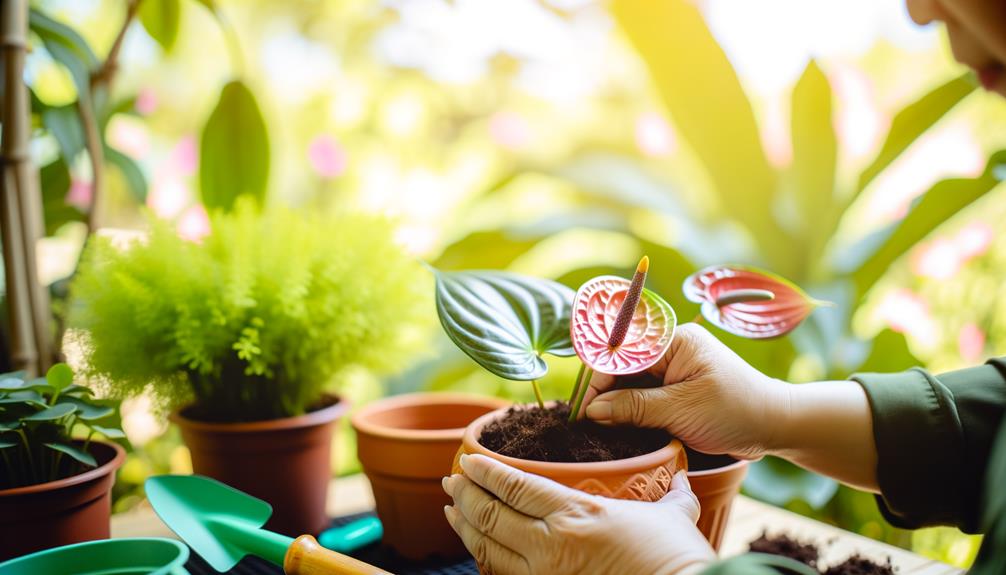
Choosing the correct pot is vital for your Anthurium’s health, promoting proper drainage and root aeration. Select a pot with multiple drainage holes to prevent waterlogging, which can suffocate the roots.
Terra cotta pots are preferred due to their porous nature, encouraging air circulation. Fill the base with a layer of coarse gravel or ceramic shards to further boost drainage.
Then, carefully position your Anthurium in the pot, gently spreading the roots. Surround the roots with succulent soil, pressing softly to eliminate air pockets but avoiding soil compaction. Position the crown just above the soil line.
Lastly, place the potted Anthurium in a spot with bright, indirect light. This setup supports ideal growth and longevity for your plant.
Watering Techniques
Ensuring your Anthurium thrives also hinges on mastering proper watering techniques, which are as critical as selecting the right pot and soil.
Begin by watering the plant thoroughly, ensuring water drains from the bottom. Watering frequency should adapt to environmental conditions.
Use these steps:
- Monitor soil moisture: Use a moisture meter or touch the soil. Water when the top inch is dry.
- Water quality: Use filtered or rainwater to prevent mineral buildup, which can harm the plant.
- Seasonal adjustments: Reduce watering in cooler months and increase it during the growing season.
Light Requirements

While anthuriums can tolerate low light conditions, providing them with bright, indirect light will significantly enhance their growth and blooming potential.
Place your anthurium near an east or north-facing window where it can receive filtered sunlight. Verify the light is diffused to prevent leaf scorch, which can occur with direct sunlight.
If natural light is insufficient, consider using full-spectrum grow lights, positioning them about 12 inches above the plant.
Aim for 10-12 hours of light daily to replicate their natural tropical environment. Rotate the plant periodically to ensure uniform light exposure.
Proper lighting not only boosts photosynthesis but also promotes robust foliage and vibrant blooms, making your anthurium a stunning centerpiece for any space.
Common Mistakes
A common pitfall in anthurium care is overwatering, which can lead to root rot and fungal infections. To avoid this, use succulent soil for its excellent drainage properties.
However, there are other mistakes you’ll want to avoid:
- Ignoring Soil pH: Anthuriums prefer slightly acidic soil (pH 5.5-6.5). Confirm your succulent soil mix aligns with this requirement.
- Inadequate Light: While succulent soil helps with moisture control, insufficient light can still stress your plant. Place your anthurium in bright, indirect light.
- Poor Pot Choice: Drainage holes are essential. A pot without them negates the benefits of succulent soil, causing water to pool at the roots.
Long-Term Care
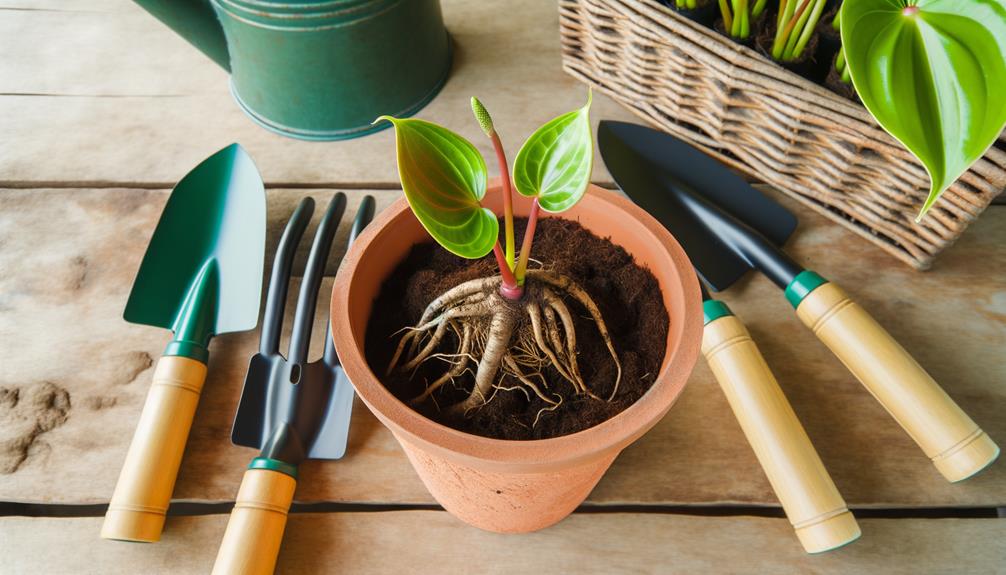
Maintaining ideal long-term care for your anthurium involves a consistent routine of proper watering, nutrient management, and environmental adjustments.
Water your anthurium when the top inch of lush soil feels dry; overwatering can lead to root rot. Use a balanced, water-soluble fertilizer once a month during the growing season to provide essential nutrients.
Make sure your plant receives bright, indirect light, as direct sunlight can scorch its leaves. Maintain a humidity level of 60-80% by using a humidifier or placing a tray of water nearby.
Regularly inspect for pests and remove any dead or yellowing leaves. Repot your anthurium every two years, revitalizing the lush soil to maintain optimal drainage and aeration.
Conclusion
So there you have it: treating anthuriums like cacti might just be the horticultural equivalent of putting a fish on a bicycle.
By using succulent soil, you’re ensuring your anthurium gets the drainage it craves without drowning in the process.
Remember, overwatering is the silent killer here—think of it as the houseplant version of binge-watching your favorite series without moving from the couch.
Proper care will keep your anthurium flourishing like it’s on a botanical runway.



